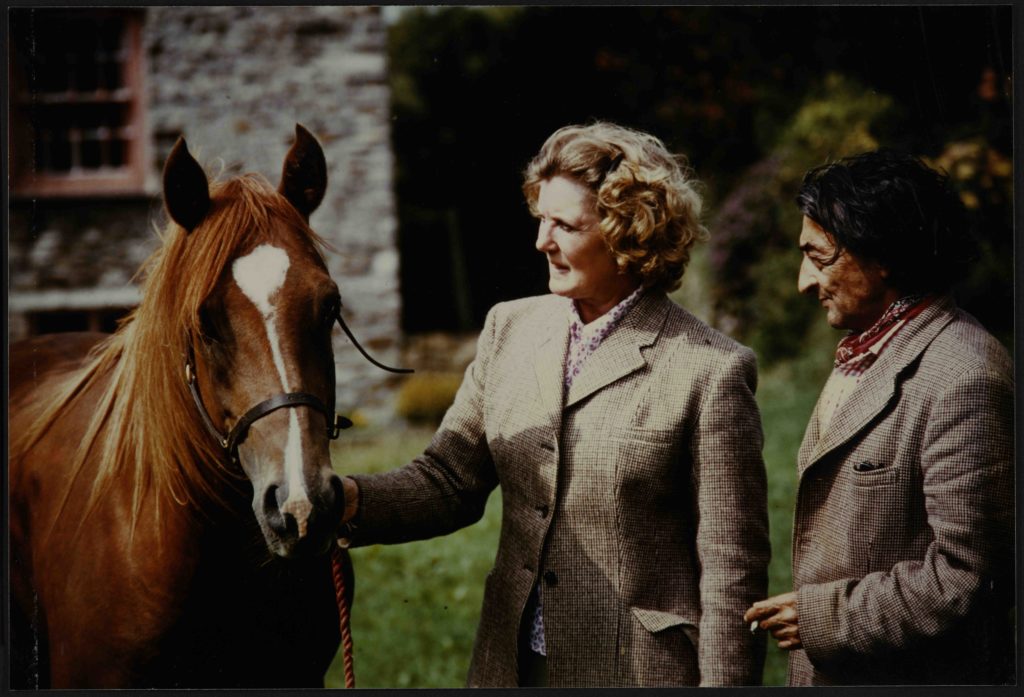[slideshow_deploy id=’569′]
This weekend will see endurance riders from across Britain descend on Exmoor for the challenging Golden Horseshoe Ride. The first ride took place on 4th September 1965 supported by the Sunday Telegraph, British Horse Society and writer Ronald Duncan. Now in its 53rd year, having survived a serious threat to its future in 2016, we delve into the archives of the Ronald Duncan Collection to find out more about how the ride came into being.
Two letters held in the archive from 19 January 1965 show Duncan’s early impetus for the race. A letter to Colonel Mike Ansell of the horse society thanks him for an article on long distance riding (sent 9 December 1964) which Duncan claims “quite convinces me that the long distance race which I envisage could be undertaken”. Duncan clearly wasted no time in getting to work on the event as a draft letter asking for sponsorship for “an open annual event run over a distance of 100 miles, terminating at Welcombe” was composed the same day. By 16 June 1965 the Sunday Telegraph is involved, and on 1 August 1965 Duncan drafted a letter to a Mr Etheridge of the Sunday Telegraph proposing various points on the route. A hand written list of points on the route also survives.
[slideshow_deploy id=’571′]
A number of drafts of material for publicity, entrance forms and programmes survive showing the evolution of the event; its name going through several iterations as The Welcombe Marathon Race, The Welcombe Long Distance Ride and The Golden Horseshoe Fifty Mile Ride. In addition, an Agenda for a meeting on 4 August 1965 concerning the ride also survives, complete with scribbled annotations. These documents show the decisions made on route, vet points, entrance fees and start dates, and all show the marked focus on horsemanship and animal welfare that continues in the ride today.
[slideshow_deploy id=’574′]
The first ride comprised on 120 riders with 80 reserves, mostly from the West Country, with some from Wales and the Midlands, nearly 2/3rds of whom were women, with a large number of the men coming from the armed forces. In 2018 there will be 260 riders taking part in more than 7 classes. A sight that I am sure Duncan would have been thrilled to see.
In a draft of Duncan’s introduction for the programme, he mentions the International Marathon Ride as one of the historical impetuses for starting the ride, and a typescript of an article by the Inspector of Calvary on The Grand International 1906 seems to bear this out. However, Duncan’s love of horses would also have been a large part of his motivation, particularly the Arab horses that he bred with his wife Rose Marie Duncan. This love of horses led to his connection with Colonel Sir Mike Ansell for whom he wrote ‘The Horse’ in 1964, which is still recited annually at the Horse of the Year Show. As with the Golden Horseshoe Ride, this poem still inspires horse lovers today and the Ronald Duncan Literary Foundation receives many requests to use it in books, magazines, conferences, calendars, artworks and funerals.
[slideshow_deploy id=’576′]
Duncan explains his deep love of horses best in his programme introduction, stating “People sometimes ask my why, I as a poet should be so fond of horses? My answer is: a horse is a poem on four legs.”
‘The Horse’ by Ronald Duncan
Where in this wide world can man find nobility without pride,
friendship without envy, or beauty without vanity?
Here where grace is laced with muscle and strength by gentleness confined.
He serves without servility; he has fought without enmity
There is nothing so powerful, nothing less violent;
there is nothing so quick, nothing more patient.
England’s past has been borne on his back.
All our history is in his industry.
We are his heirs;
He is our inheritance.
Best of luck to all the riders this weekend!

Ronald and Rose Marie Duncan with horse